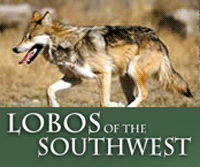For Immediate Release, August 21, 2025
Contact:
Michael Robinson, Center for Biological Diversity, (575) 313-7017, This email address is being protected from spambots. You need JavaScript enabled to view it.
Greta Anderson, Western Watersheds Project, (520) 623-1878, This email address is being protected from spambots. You need JavaScript enabled to view it.
Chris Smith, WildEarth Guardians, (505)395-6177, This email address is being protected from spambots. You need JavaScript enabled to view it.
Sandy Bahr, Sierra Club – Grand Canyon (Arizona) Chapter, (602) 999-5790, This email address is being protected from spambots. You need JavaScript enabled to view it.
Claire Musser, Grand Canyon Wolf Recovery Project, (928) 202-1325, This email address is being protected from spambots. You need JavaScript enabled to view it.
Federal Gunmen Shoot Endangered Mexican Gray Wolf Pup, Target Second Wolf
SILVER CITY, N.M.— Newly released records reveal that the U.S. Fish and Wildlife Service recently ordered the U.S. Department of Agriculture to kill two genetically valuable Mexican gray wolves. One of them — a 3-month-old female pup on the Gila National Forest in New Mexico — was shot from the air last week.
The other targeted wolf, a young adult male in the Bear Canyon pack, is still alive in the Apache National Forest in Arizona. The Department of Agriculture shot his mother from the air in April while she was thought to be pregnant. Recently, he has found a mate with whom he now travels.
“Gunning down a wolf pup from the air whose precious genes could have helped save her entire subspecies was cruel and will further stall recovery of these animals,” said Michael Robinson, a senior conservation advocate at the Center for Biological Diversity. “There’s still time to call off the helicopter gunmen and halt another unjust execution. One killing is too many, and the death of a second wolf would be heartbreaking.”
The Center for Biological Diversity has requested the Fish and Wildlife Service and Arizona Game and Fish Department call off the kill order.
“The responsibility for preventing livestock conflict with native carnivores on public lands rests with the livestock operators,” said Greta Anderson, deputy director of Western Watersheds Project. “Wolves shouldn't have to pay with their lives for taking advantage of the easy prey left unattended in wolf habitat, and nor should the recovery effort be driven by the livestock industry's wolf removal agenda.”
Like the wolf who was already killed, the young male wolf has genes that are underrepresented in the population. Previous government wolf killings and a shutdown almost two decades ago on releases of well-bonded family packs to the wild led to significant losses of genetic diversity. Genetically rare wolves like those targeted can aid recovery because they are not as closely related to other wolves.
Mexican wolves already suffer from physiological and reproductive ailments caused by lack of genetic diversity.
“The ongoing assault on the wild, natural world is reflected in these gross kill orders,” said Chris Smith, wildlife program director for WildEarth Guardians. “People should be asking: why do imperiled, native wildlife have to make way for private profit?”
“The last thing the U.S. Fish and Wildlife Service — the agency charged with the recovery of these wolves — should be doing is ordering the killing of these highly endangered animals, especially those that are so genetically important to the population,” said Sandy Bahr, director of Sierra Club’s Grand Canyon chapter. “We need to require that livestock interests do more to limit conflicts and stop merely killing wolves on their behalf.”
“This is not recovery, it’s a moral failure. Killing a 3-month-old wolf pup from a helicopter shows how far federal management has strayed from science, ethics and public trust,” said Claire Musser, executive director of the Grand Canyon Wolf Recovery Project. “Let lobos lead and allow them to become active agents in their recovery. Wolves belong. They are sentient, social beings who deserve the chance to raise families and shape the landscapes they inhabit. It’s time to move beyond reactive removals and invest in proactive conflict mitigation.”
Background
Starting in 1915 the U.S. government trapped and poisoned Mexican wolves and destroyed pups in their dens on behalf of the livestock industry, expanding its efforts in 1950 to killing wolves in Mexico and only stopping after the 1973 passage of the Endangered Species Act. Descendants of seven survivors who were captured and bred were reintroduced to the Southwest in 1998 and to northern Mexico in 2011.
Since President Trump’s return to office this year, the Fish and Wildlife Service has ramped up removals, with state support. These removals include:
- April 14: The mistaken identity shooting of the likely pregnant, genetically valuable matriarch of the Bear Canyon pack in the Apache National Forest. This wolf was the mother of the young male wolf now being targeted.
- April 22: The killing of the father wolf of the Hail Canyon pack on a severely grazed allotment in the Gila National Forest, where for decades cattle that died of non-wolf causes attracted wolves to scavenge. There is no information that the Hail Canyon pack had scavenged on carrion.
- May 27: The live capture of the parents and two pups, along with the deliberate killing of a third pup, who comprised the southernmost wolf family in the United States, the ManÞada del Arroyo pack, in the Coronado National Forest in Arizona. This family includes genetically valuable wolves.
- Aug. 12: The aerial shooting of the 3-month-old, genetically valuable female from the Dillon Mountain pack in New Mexico.





